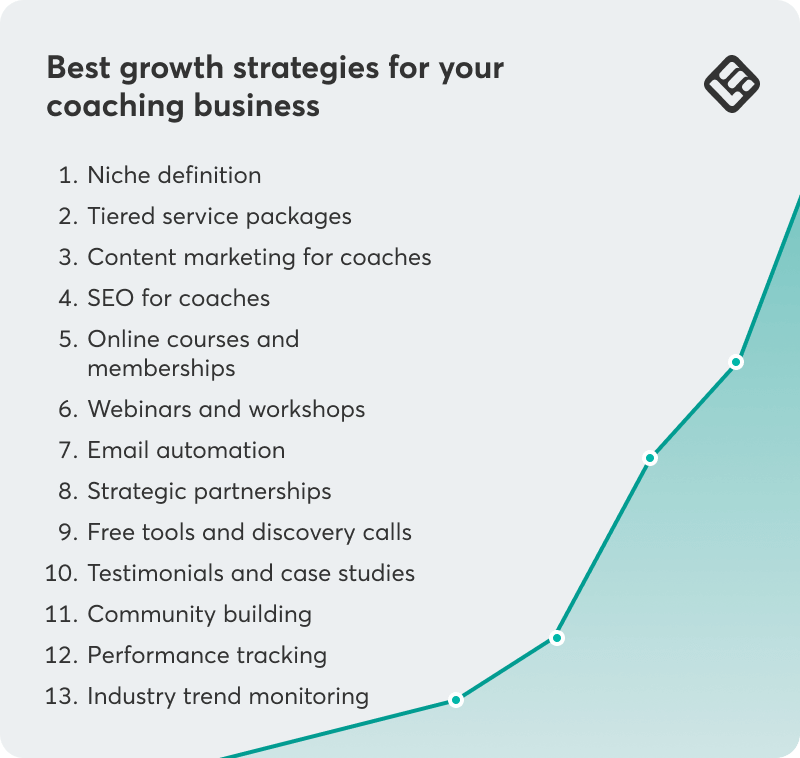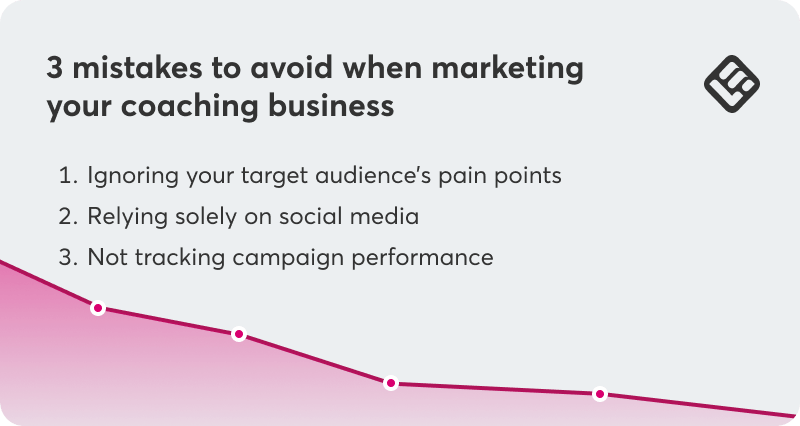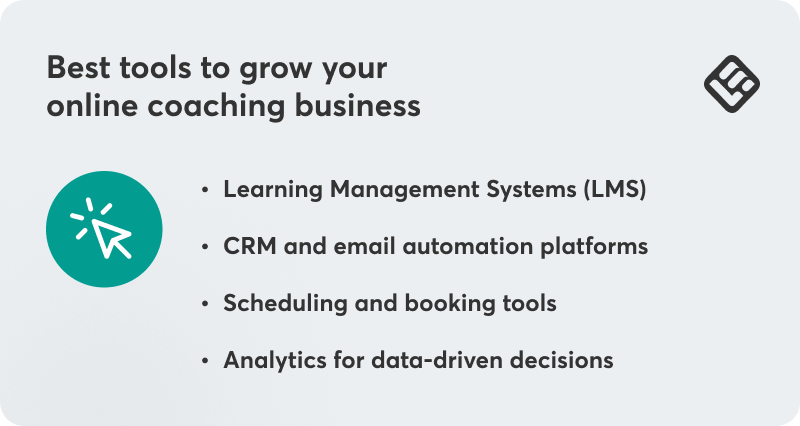Table of Contents
Heads up: Right now, the coaching industry is a 7.31 billion dollar industry [1]. And online coaching? It’s set to grow 14% between 2023 and 2032 [2]. So you’ve got the right idea. The time to grow your online coaching business? Right now.
If you’ve got a solid business but are struggling to take it to the next level, you’re in the right place. I’ve put together 13 coaching business growth strategies that are easy to use, and you can start applying them right away.
Mapping out your processes to grow your coaching business
First things first, you need to make sure your coaching systems can handle growth. If your backend isn’t built to support more coaching clients, any new effort may fall flat. So before you jump into these strategies, review things like your:
Are you still handling every task yourself? Do your systems support more clients without adding more hours to your workweek?
If you’re trying to scale your coaching business, your focus should shift from doing everything manually to using tools and workflows that save you time.
13 coaching business growth strategies
There’s no single effective marketing strategy for building a coaching business that lasts. Some support and try several marketing ideas to promote online courses, some help you understand tiered service packages, and some are multipurpose.
These tips can help you understand how to market your coaching business and support its growth. The trick is focusing on the methods that will benefit your business the most and applying them strategically.

1. Niche definition
When your offer is too broad, people can’t tell if it applies to them. Clear positioning helps the right clients recognize that your service is made for what they need.
Try this: What do your top three clients have in common? Was there something highly specific they wanted your help with? What kind of transformation or progress did they reach after working with you?
Once you can describe who you help and what result you help them achieve, update your homepage, your email signature, your social media bios—anywhere future clients will come across your services. To sell online coaching services, it should be easy for prospects to say, “Yes, that’s exactly what I need.”
2. Tiered service packages
Due to budget or preferences, some clients may not want private 1:1 coaching. Tiered offers help you meet different client needs and give them something to choose from.
Here’s a simple model to consider:
Entry-level: A mini-course, workshop, or template bundle
Mid-tier: Group coaching or a guided course with some live touchpoints
Premium: Private coaching, possibly with ongoing voice or chat support
Using a tiered structure gives clients a path to grow with you and helps you manage your time better as your audience grows.
💡Keep learning: Popular coaching models for online businesses
3. Content marketing for coaches
Marketing coaching businesses should help potential clients understand what it’s like to work with you. But it also needs to move them toward a decision, not just inform or inspire.
Focus your content on showing what problems you solve and how you help clients see results. Use stories from clients—with their permission—or even short lessons from your personal experiences. Choose one or two marketing platforms to focus on and get consistent with those before branching out to others.
4. SEO for coaches
You may have seen around the internet that SEO is dead, but as someone who works with it daily, I say it’s alive and well. And experts over at Semrush back me up. SEO or search engine optimization is changing, yes, but it’s still a viable way to reach and connect with more clients.
SEO for coaches means writing pages and blog posts that answer specific questions your ideal clients search for. Check out search results, not just on Google, but on YouTube and Reddit too. When you’re ready to create, focus on clarity, structure, and content that reflects how you help people.
5. Online courses and memberships
Courses work best when they solve one problem, especially one you have already coached people through. Before building anything big, run a live version and ask for feedback. From there, you’ll know what to add or polish before turning it into a full online coaching course.
Set up membership options for clients who want long-term support or accountability. Many coaches turn their course into a membership by adding monthly Q&A calls or bonus resources.
6. Webinars and workshops
If you want to move someone from “interested” to “ready to work with you,” webinars can help. Choose one outcome for your workshop, stick to it, and deliver usable insight. Use real examples and invite questions and discussions, and always, always end with a clear next step.
To promote it, invite your email list and two or three past clients to start. A smaller group helps you build confidence while testing what content resonates before you start the workshop for prospects.
7. Email automation
My favorite email subscriptions are ones where the author makes me feel like I’m part of a conversation. I’m not just being pitched to, but I’m part of the process, a community where we look at common issues and discover solutions together.
When you’ve got your email content down, automating it can help you stay consistent and free you up to focus on other aspects of your coaching business. Your emails can be scheduled through an email marketing platform, but write them like you would if you were just checking in on a potential client you met last week.
8. Strategic partnerships
A strategic partnership is a collaborative relationship with other business owners who serve a similar audience. The goal isn’t just to swap referrals, but to create something that benefits both of your clients.
The most effective strategy for me turned out to be partnering with other experts. In our case, these were HR specialists and career development mentors. We didn’t create large educational products – just small webinars, Q&A meetings, or guest workshops for the team. But the effect was impressive: curiosity, engagement, and people’s desire to apply the coaching approach to their work grew. It works because the trust the team has in me as the head of the marketing department is partially transferred to the experts I involve. And vice versa – the audience of the invited expert begins to learn about our approach, our culture, our brand.
Let’s say you’re a business coach and you connect with a DEI consultant who works with corporate teams. You might:
These collaborations can help you with marketing your coaching business and can lead to warm referrals and build audience trust long term.
9. Free tools and discovery calls
Free tools are lead magnets, resources that give value up front in exchange for someone’s contact info. Think quizzes, worksheets, checklists, or email challenges. They are an important part of marketing coaching businesses and should help the client understand their problem better or take the first step toward solving it.
As an SEO coach, I developed quickly through serving people without taking anything first. I actually lived SEO fix sessions and gave real results, and not just words. That caused people to believe me and be interested to know more. All the tips that I discussed were explicit, straightforward, and incredibly helpful. The common response was, when something is free, then the money stuff should be great. By giving first and selling afterwards, success is the logical thing that happens.
Discovery calls are short, no-pressure conversations designed to help both you and the potential client decide if there’s a good fit. Keep them respectful of the other person’s time, like 15 to 30 minutes, and framed around clarity for what you do rather than hard selling.
10. Testimonials and case studies
You can post testimonials and case studies anywhere prospective clients might come across your services, like social media, your website landing page, or email marketing efforts. When collecting testimonials or client success stories, always get permission from your clients to share them first.
Ask clients what their life or business looked like before coaching and what results they’re experiencing now. When I gather testimonials from clients, I also ask them about what it was like to work with me. This helps prospects gain a better understanding of that from a client perspective.
11. Community building
If your work thrives on peer support or shared accountability, access to an online community can become a core part of your coaching offer.
My scaling of my coaching business depended on a single principle: creating a community that really connects. My attention was paid to providing very relevant and actionable information that was tailored to the pains and aspirations of my audience. I did not depend on some generic counsel and shallow participation. Instead, I created a platform on which people felt understood and assisted. This was not about sending out a message but about initiating discussions.
Having a community can help grow your business by:
To get started, choose a place your audience already visits, like Facebook Groups, or host it through your course platform. Give the group a clear purpose, like weekly accountability or Q&A support, and grow from there.
12. Performance tracking
Performance tracking is simply reviewing how your coaching business is doing over time. This includes numbers like how many leads you got, how many paid ads converted, email open rates, or course completion stats.
You don’t need advanced tools, and if you use a learning management system to host your coaching services, you might already have what you need. Tracking shows you what’s working and what needs to be adjusted so you can make sure your services match your clients.
13. Industry trend monitoring
Trend monitoring means staying aware of shifts in your coaching niche, whether that’s new tools or popular content formats. Keeping track of industry trends:
Staying sharp on trends helps you make smarter moves and keeps your coaching relevant.
Marketing for coaching businesses: Mistakes to avoid
Sometimes you’re doing all the “right” things and still not getting the traction you expected. When that happens, it’s tempting to think you need to work harder or add more to your plate.
But there are often simple solutions when marketing for coaching businesses.
If your growth has stalled or your audience isn’t converting, these are three blind spots worth checking. They’re easy to miss—but totally fixable once you know where to look—and will help you see how to market your coaching business better.

Ignoring your target audience’s pain points
If your marketing efforts aren’t landing, chances are they’re too focused on your offer and not enough on the problem your client is trying to solve. Prospective clients are looking for outcomes, so make sure your content and sales pages reflect your audience’s struggles.
Instead of “8-week confidence program,” for example, say “Build confidence to speak up at work in only 8 weeks.” This lets prospects know exactly what to expect and the results they’ll get.
Relying solely on social media
Social media is a great visibility tool, but it’s not a full marketing system. Algorithms shift, reach drops. Nothing you create on social media is guaranteed to stay or stay successful, so while I don’t recommend dropping it, you want to make sure you have backups that are totally yours.
Use socials to start conversations, but move people to channels you control. That might be your email list, a private group, or your own course platform. That way, when someone’s ready to buy, you’re not relying on the algorithm to make the connection.
Not tracking campaign performance
Without tracking performance, how can you tell what’s working and what isn’t? Tracking is one of the best ways to check in with your business and see how your audience responds to different content and coaching methods.
Track key numbers monthly: email clicks, call bookings, conversion rates, and where leads are coming from. When you know what’s working, marketing becomes a lot less overwhelming and way more effective.
Final tips for marketing a coaching business
Once the basics are in place, step back and keep your marketing moving. Consistently providing valuable content is essential to engage a wider audience and build trust. Remember, your marketing activities should be aligned with your business goals and tailored to your unique coaching approach.
These are a few habits that support long-term growth without overcomplicating your work.

Prioritize value over volume in content
When creating content, aim to answer real questions or help someone understand a challenge they’re facing. A single clear insight or helpful tip is often more effective than a long list of ideas or frequent updates with no clear focus.
Compelling content is key to capturing your audience’s attention and encouraging them to take action. Start by keeping a list of questions clients or leads ask you and use those as the basis for future content.
Stay consistent with your messaging
If you went to a shop that boasts great ice cream options, only to go back the next month and find the same company selling custard pies instead, I bet you’d be a bit confused. They might even lose a bit of your trust.
Maybe that analogy is a bit thick, but the point is that if you change your focus too much, your clients will be confused.
My greatest growth strategy was to emphasize establishing good and personal relationships with clients. I listened much because I was there to listen to what they actually wanted, and this was not only in the coaching, but in their lives. People will see you when you appear to them regularly. Customers began to recommend others since they got the impression that I was interested in their success. It had nothing to do with the best marketing or the best sales pitch, it was a matter of being there when they needed me and doing what I said I was going to do.
If your core message shifts too often, it can be harder for potential clients to recognize whether your service is the right fit for them. Choose a focus and use that consistently across your channels.
Collaborate with aligned professionals
Collaboration can be a powerful and fun way to reach new audiences, especially when you work with people whose services complement yours. That might mean co-hosting a live session or sharing each other’s resources in a newsletter.
Attending networking events, both online and offline, can help you connect with potential collaborators and expand your reach. Start with a few light, low-stakes opportunities to work together and build from there if you like the way things are going.
Invest in ongoing learning and technology
We live in a time with excellent tools available for coaching. And the market is growing: 13.7% projected between 2025 and 2037, which means new platforms and systems are constantly becoming available.
Look for tools that support how you work, like LMSs or a good CRM (customer relationship management). And if you want to sharpen your marketing or content skills, there are plenty of short, focused trainings, like on content marketing for coaches, in places like YouTube or Udemy.
💡Keep learning: 12 best online coaching platforms for 2025
The best tools to help grow coaching businesses online
Speaking of tools, certain platforms make it easier to teach and grow coaching businesses.
The options below cover core areas including course delivery, communication, scheduling, and performance tracking, so you can support clients and run your business more smoothly.

Learning Management Systems (LMS)
A learning management system (LMS) helps you organize and deliver your courses in one place. It’s what allows clients to log in, track progress, and learn at their own pace. If you offer self-guided programs or plan to, this is one of the first tools to set up.
CRM and email automation platforms
A CRM keeps track of leads and clients, while automation tools, like email marketing for elearning businesses, let you stay in touch without sending everything manually. Together, they help you attract clients and keep your marketing running even when you’re focused on coaching.
Scheduling and booking tools
Scheduling tools make it easier for new clients to book sessions and give you control over your calendar. They prevent double-bookings and let you set clear availability without email back-and-forth.
When choosing a tool, look for:
Some tools also let you collect pre-call questions, take payments, or even set different rules for different types of sessions.
Analytics for data-driven decisions
Analytics and reports show you what’s working and where to adjust. For coaching businesses, that might include email click rates, discovery call conversions, or where leads found you. Checking a few key numbers regularly can help you focus your time and energy on what brings in clients and what they’re looking for.
💡Keep learning: 9 top AI coaching platforms to choose for your business
Grow your coaching business with LearnWorlds
If you’ve noticed these marketing strategies and sales funnels involve a lot of moving parts, you’d be right. To stay organized, it can help to have as many of those moving parts as possible all in one place.
LearnWorlds is a powerful, fully white-label LMS you can use to host courses, track analytics, and build your coaching communities. It’s chock-full of features designed to help you grow and manage your coaching business.
The platform helps reinforce your brand by providing a consistent and professional experience for your clients, ensuring your brand identity is reflected across all touchpoints.
Some key LearnWorlds features for coaches include:
Start a free trial today and see how LearnWorlds can support your online coaching business.
Sources
[1] Global Coaching Study [2] Allied Market Research: Online Coaching Market Research, 2032
Ciera Lamb
Ciera is a freelance content writer and editor connecting companies with their ideal audiences through blog articles and other online content. She approaches her writing with curiosity and research and enjoys the ever-present learning that comes with being a content writer. She is also an avid scuba diver, an aspiring Dutch speaker, and lover of all things nature.
FAQ
Everything you have ever wondered, but were too afraid to ask...




